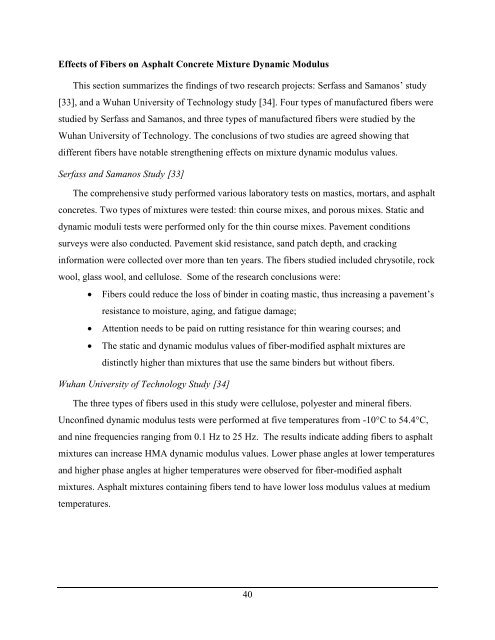Modification of Dynamic Modulus Predictive Models for Asphalt ...
Modification of Dynamic Modulus Predictive Models for Asphalt ...
Modification of Dynamic Modulus Predictive Models for Asphalt ...
You also want an ePaper? Increase the reach of your titles
YUMPU automatically turns print PDFs into web optimized ePapers that Google loves.
Effects <strong>of</strong> Fibers on <strong>Asphalt</strong> Concrete Mixture <strong>Dynamic</strong> <strong>Modulus</strong><br />
This section summarizes the findings <strong>of</strong> two research projects: Serfass and Samanos’ study<br />
[33], and a Wuhan University <strong>of</strong> Technology study [34]. Four types <strong>of</strong> manufactured fibers were<br />
studied by Serfass and Samanos, and three types <strong>of</strong> manufactured fibers were studied by the<br />
Wuhan University <strong>of</strong> Technology. The conclusions <strong>of</strong> two studies are agreed showing that<br />
different fibers have notable strengthening effects on mixture dynamic modulus values.<br />
Serfass and Samanos Study [33]<br />
The comprehensive study per<strong>for</strong>med various laboratory tests on mastics, mortars, and asphalt<br />
concretes. Two types <strong>of</strong> mixtures were tested: thin course mixes, and porous mixes. Static and<br />
dynamic moduli tests were per<strong>for</strong>med only <strong>for</strong> the thin course mixes. Pavement conditions<br />
surveys were also conducted. Pavement skid resistance, sand patch depth, and cracking<br />
in<strong>for</strong>mation were collected over more than ten years. The fibers studied included chrysotile, rock<br />
wool, glass wool, and cellulose. Some <strong>of</strong> the research conclusions were:<br />
Fibers could reduce the loss <strong>of</strong> binder in coating mastic, thus increasing a pavement’s<br />
resistance to moisture, aging, and fatigue damage;<br />
Attention needs to be paid on rutting resistance <strong>for</strong> thin wearing courses; and<br />
The static and dynamic modulus values <strong>of</strong> fiber-modified asphalt mixtures are<br />
distinctly higher than mixtures that use the same binders but without fibers.<br />
Wuhan University <strong>of</strong> Technology Study [34]<br />
The three types <strong>of</strong> fibers used in this study were cellulose, polyester and mineral fibers.<br />
Unconfined dynamic modulus tests were per<strong>for</strong>med at five temperatures from -10°C to 54.4°C,<br />
and nine frequencies ranging from 0.1 Hz to 25 Hz. The results indicate adding fibers to asphalt<br />
mixtures can increase HMA dynamic modulus values. Lower phase angles at lower temperatures<br />
and higher phase angles at higher temperatures were observed <strong>for</strong> fiber-modified asphalt<br />
mixtures. <strong>Asphalt</strong> mixtures containing fibers tend to have lower loss modulus values at medium<br />
temperatures.<br />
40
















